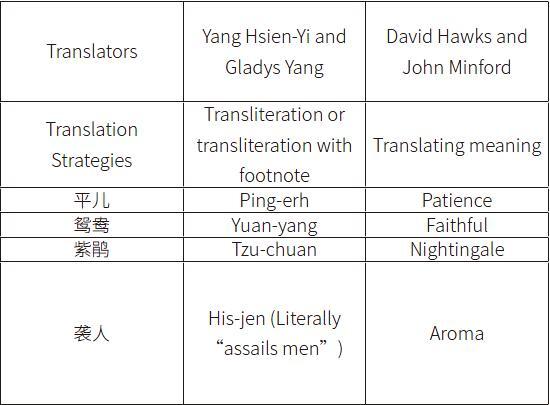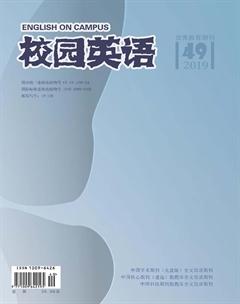Translation of Character Names in the two English Versions of Hongloumeng

【Abstract】In the two complete translations by Yang Hsien-Yi and Gladys Yang and David Hawks and John Minford, charater names are translated with different strategies, which are respectively transliteration and translating meaning. A closer look at the background information of the two versions leads to the conclusion that the differences in charater name translation strategies are justified from the perspective of the skopos theory.
【Key words】 character names; translation strategies; the skopos theory
【作者簡介】李桂芝,石家莊鐵道大學外語系,副教授,碩士,研究方向:翻譯理論與實踐。
【基金項目】河北省高等教育教學改革研究與實踐項目,課題號:2018GJJG231,“中國工程技術話語體系構建背景下英語專業翻譯課程改革研究”。
Ⅰ.Introduction
Hongloumeng by Cao Xueqin has been long held as one of the great masterpieces of Chinese literature. Its complicated characters, relationships and plot pose a great challenge to translators. The two well known complete translations of Hongloumeng are A Dream of Red Mansions by Yang Hsien-Yi and Gladys Yang and The Story of the Stone by David Hawks and John Minford. Both are well accepted translation of the Chinese original, yet after a close reading of the two versions one may find that there are a lot of differences between them concerning the translation of the book title, the character names, the idioms and puns, to name just a few. For example, 王熙鳳對賈母說:……舉眼看看,誰不是兒女?難道將來只有寶兄弟頂了你老人家上五臺山不成?(292,chap 22)The two versions are:
1.Look, arent all of us your children? Is Pao-yu the only one wholl carry you as an immortal on his head to Mount Wutai? (Footnote: Mount Wutai was a holy Buddhist mountain. (312, Y&D)
2.You forget, Grannie, when you go to heaven young Bao-yu wontt be the only one wholl walk ahead of the hearse. (433, Hawks).
It can be seen that Y&Ds version is more source culture oriented while Hawks version more target culture oriented. The skopos theory may serve as a perspective in discussing such prominent differences.
Ⅱ.Literature review
In his book A Skopos Theory: Some arguments for and against, Vermeer briefly repeats the main axioms, definitions and assumptions of skopos theory in the form of theses. Vermeer starts from the assumption that all acting is goal-oriented, and since translating is a kind of acting, translation is goal-oriented. Thus, he comes to the conclusion, which is the basic rule of the skopos theory: The skopos of (translational) acting determines the strategy for reaching the intended goal (Vermeer 1996: 12-15). In the linguistically oriented approach, the translator has to be faithful to the original text and the evaluation of the target text will be based on its faithfulness to the source text. While here, the skopos theory allows for different strategies and versions of the same source text based on different skopoi. A source text is usually composed originally for a situation in the source culture. The target text, the translatum, is oriented towards the target culture, and the reason why the target text is needed may and (in most cases so) be different from the intention of the author/producer of the source text, so if the translator just sticks to the source text, whether its content or style or ‘spirit, he may not produce a target text that meets the need of the present. The theory “asks only that translators strive for optimal solutions within actual existing conditions” (Gentzler 2001: 71). What translators take into consideration when faced with some translation problems is what strategy may best fulfill the skopos, and of course they should evaluate the knowledge and expectations of the assumed readers.
Ⅲ. Background information of the two versions and translation strategies of charactrer names
Of all the translations of Hongloumeng, the two complete versions of Y&D and Hawks have received a lot of interest from researchers. A lot of differences have been made explicit by some reserachers with either praise or criticism on this version or that. It is a pity, howerer, that some sholars ignore the purpose of the translator in evaluating the two versions. The publisher of Y&Ds version is Foreign Language Press with Chinese as its main potential readers while that of Hawks is Penguin Books with westerners who are interested in literature as its potential readers. The skopos of Y&Ds version is to introduce Chinese culture and value ‘faithfulness to ST (qtd in Zhang Kun: 101) while that of Hawks is to translate everything and convey to the reader the pleasure this Chinese novel has given him (see the preface in Vol. I). Inferring from the skopos of each version, Y&D tend to be ST-oriented and Hawks Reader-oriented.
The following is a table showing the traslation strategies of some character names of the two versions.
Translators Yang Hsien-Yi and Gladys Yang David Hawks and John Minford
Translation Strategies Transliteration or transliteration with footnote Translating meaning
平兒 Ping-erh Patience
鴛鴦 Yuan-yang Faithful
紫鵑 Tzu-chuan Nightingale
襲人 His-jen (Literally “assails men”) Aroma
It can be seen from the table that Y&D mainly adopts the strategy of transliteration and for those names with special meanings transliteration is employed with footnote for further explanation, while Hawks mainly translates the meaning of names, to make the story more interesting and save the readers a lot of trouble distinguishing who is who. As potential readers of Y&Ds version are mainly Chinese, and most Chinese have already read the Chinese version of Hongloumeng, so transliteration of names is adopted in their version. While potential readers of Hawks verison are westerners with interest in literature, the translators interpretaiton of the meaning of character names is presented taking the readers feeling into consideration. What is worth mentioning is that “紫鵑” is translated as “nightingale” by Hawks, as “cuckoo (紫鵑)” will arouse in the readers some bad feeling (Cuckoo implies unfaithfulness of husband or wife). The skopos of Y&D is to introduce the Chinese culture and be faithful to ST, and by transliteration (or transliteration with footnote) of character names such skopos is well achieved. While Hawks aims to “communicate some of the enchantment to other people” (see a letter from David Hawks), his translating meaning of names is well justified. As space is limited, examples listed in the table are only a tiny part of the whole, and in future work detailed categorization and analysis will be made.
Ⅳ. Conclusion
It would be too rush to reach a conclusion that the differences in translation strategies in the two versions are a result of the difference in respective skopos, and actually it is not the aim of the present paper. The paper aims to show that skopos theory serves a new perspective of seeing the differences in translation strategies. So long as they help better achieve the skopos, all strategies are justified. If there are 1,000 skopoi, there should be 1,000 versions of a ST. And in carrying out translation critique, “evaluate a translation by its skopos instead of strategies will carry great influence on literary translation” (Wen Jun 2003: 52). So translation skopos should be taken into consideration in translation discussion or critique.
References:
[1]Gentzler, Edwin (2001) Contemporary Translation Theories (Revised Second Edition). Clevedon: Multilingual Matters Ltd.
[2]Hawks, David (trans.) (1973, 1977, 1980) The Story of the Stone (Vol. 1-3). Harmondsworth: Penguin Books.
[3]Vermeer, Hans J. (1989) ‘Skopos and Commission in Translational Action (trans. Andrew Chesterman) in Andrew Chesterman (ed.) Readings in Translation Theory. Finland: Oy Finn Lectura Ab, 173-187.
[4]Vermeer, Hans J. (1996) A Skopos Theory of Translation (Some Arguments for and against). Heidelberg: TEXTconTEXT-Verlag.
[5]Yang, Hsien-yi and Gladys Yang (trans.) (1978) A Dream of Red Mansions (Vol. 1-3). Beijing: Foreign Languages Press.
[6]曹雪芹,高鄂.紅樓夢(上下)[M].北京:人民文學出版社,2002.
[7]張南峰.中西譯學批評[M].北京:清華大學出版社,2004.
- 校園英語·上旬的其它文章
- Of whether the geographical factors lead to the differences between the Hakka people’s festivals and the Central Plains people’s festivals
- Ramsey Numbers
- Chinese and Western Perspectives on Rise of China
- “The thirteenth Five-Year Plan”and China’s Financial stability issues
- 圣潘塔利昂
- A Study on Relationship between Realism and Reality under Intense Technological Change

